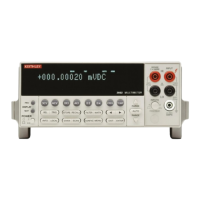B
Interface Function Codes
B-1
The interface function codes, which are part of the IEEE-488
standards, define an instrument’s ability to support various
interface functions and should not be confused with
programming commands found elsewhere in this manual.
The interface function codes for the Model 2002 are listed in
Table B-1. The codes define Model 2002 capabilities as
follows:
SH (Source Handshake Function) —
SH1 defines the abil-
ity of the instrument to initiate the transfer of message/data
over the data bus.
AH (Acceptor Handshake Function) —
AH1 defines the
ability of the instrument to guarantee proper reception of
message/data transmitted over the data bus.
Table B-1
Model 2002 interface function codes
Code Interface function
SH1
AH1
T5
L4
SR1
RL1
PP0
DC1
DT1
C0
E1
TE0
LE0
Source Handshake capability
Acceptor Handshake capability
Talker (basic talker, talk-only, serial poll,
unaddressed to talk on LAG)
Listener (basic listener, unaddressed to listen
on TAG)
Service Request capability
Remote/Local capability
No Parallel Poll capability
Device Clear capability
Device Trigger capability
No Controller capability
Open collector bus drivers
No Extended Talker capability
No Extended Listener capability
T (Talker Function) —
The ability of the instrument to send
data over the bus to other devices is provided by the T func-
tion. Instrument talker capabilities (T5) exist only after the
instrument has been addressed to talk.
L (Listener Function) —
The ability for the instrument to
receive device-dependent data over the bus from other
devices is provided by the L function. Listener capabilities
(L4) of the instrument exist only after it has been addressed
to listen.
SR (Service Request Function) —
SR1 defines the ability
of the instrument to request service from the controller.
RL (Remote-Local Function) —
RL1 defines the ability of
the instrument to be placed in the remote or local modes.
PP (Parallel Poll Function) —
The instrument does not
have parallel polling capabilities (PP0).
DC (Device Clear Function) —
DC1 defines the ability of
the instrument to be cleared (initialized).
DT (Device Trigger Function) —
DTI defines the ability of
the Model 2002 to have readings triggered.
C (Controller Function) —
The instrument does not have
controller capabilities (C0).
TE (Extended Talker Function) —
The instrument does
not have extended talker capabilities (TE0).
LE (Extended Listener Function) —
The instrument does
not have extended listener capabilities (LE0).
E (Bus Driver Type) —
The instrument has open-collector
bus drivers (E1).

